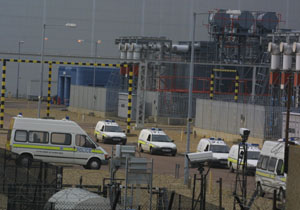
Sizewell B: police vans arrive at Sizewell
On 13th January, Greenpeace volunteers exposed the complete lack of security at Britain's flagship nuclear power station, Sizewell B, when they were able to walk en masse into the plant and easily gain access to the plant's control building and reactor dome. Disturbingly, this was the second time Greenpeace volunteers were able to break into the nuclear site. In October 2002, 140 volunteers encountered little security as they breached the perimenter fence and occupied rooftops.
Governments have known since the 1990's that terrorists have regarded nuclear power plants as potential targets. Since intelligence reports that the fourth hijacked plane involved in the September 11th 2001 attacks on the United States may have been heading for the nuclear plant at Three Mile Island in Pennsylvania, this concern has increased. The UK Office of Civil Nuclear Security (part of the Department of Trade and Industry) have now had to admit that nuclear power plants are possible terrorist targets. The most likely scenarios for an attack range from insider sabotage or theft of nuclear materials to outside invasion or assault on a nuclear reactor or waste store.
Overall, the nuclear industry defends its plants against natural and accidental incidents on the basis of 'as chance would have it' and it provides protection against human error by designing the systems and equipment to be tolerant and/or independent of human action (or inaction). This approach may have some effect in safeguarding the plant against accidents and unintentional human error but it could prove woefully ineffective against intentional and intelligently driven acts of terrorism.
For some 12 years now, America has deemed the threat of a terrorist attack on a nuclear power station to be serious enough to identify specific types of threat and test their ability to respond to them by so-called 'force en force trials'. These threats - called Design Basis Threats (DBTs) - only cover very few of the possible eventualities, but the fact that the US authorities even attempt to address them puts the Americans far ahead of our own nuclear security arrangements.
The truly alarming fact is that the UK simply does not incorporate a requirement for its nuclear power stations and plants to be tested against what are now considered to be credible acts of terrorism. Nuclear safety and the emergency planning legislation do not take account of terrorism in any detail whatsoever.
In fact, unlike the United States where DBTs are assumed to be real, physical attacks on the power stations, the plan to protect nuclear plants the UK relies upon detecting the terrorist intent in good time to be able to avert the attack, rather than requiring the operator to physically modify and strengthen the plant. This effectively means that there are no security measures that would effectively negate the damage of a deliberate attack other than catching any would be terrorists before they find themselves in a position to inflict harm. This approach therefore relies almost entirely on the effectiveness of our intelligence services, leaving absolutely no room for error whatsoever.

